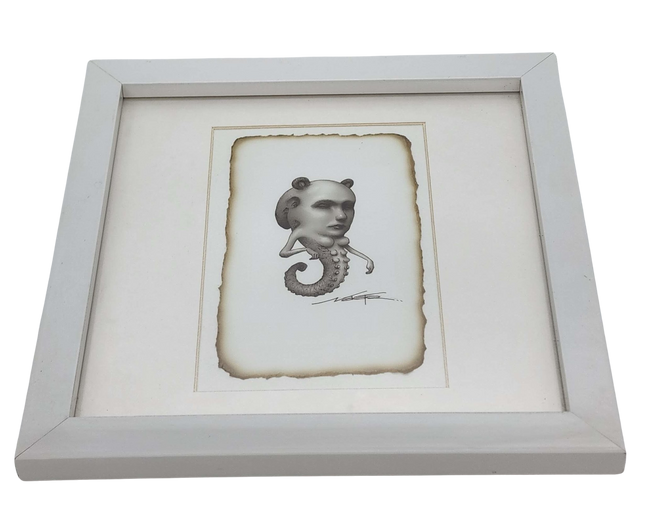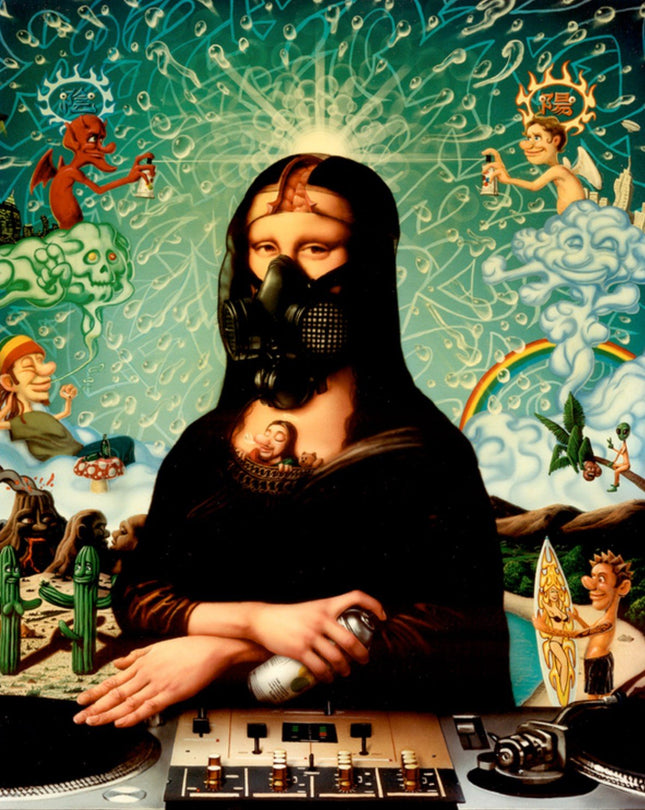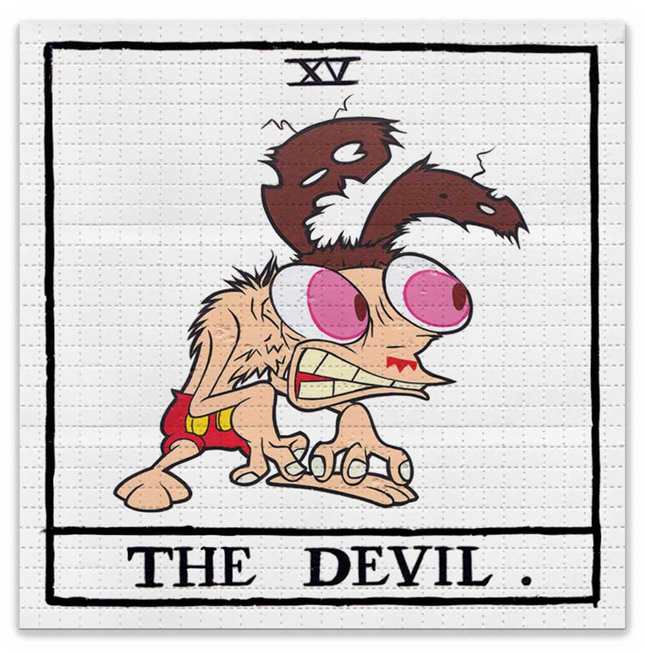
Devil Demons & Satan

Naoto Hattori Tripping Devil Original Graphite Pencil Drawing by Naoto Hattori
Tripping Devil is an original hand-drawn art drawing on framed, hand-deckled, aged art paper by Surreal Artist Naoto Hattori. 2012 Signed Original One of a Kind Pencil/Graphite Drawing Framed Artwork Frame Size 8.5x8.5 Image Size 3x5 Custom Framed & Matted By Artist. The Fusion of Street Pop and Graffiti Art in Naoto Hattori's Work The intersection of street pop art and graffiti represents a vibrant and often rebellious art form that seeks to challenge traditional aesthetics, present social commentary, and engage public spaces as a canvas for expression. Naoto Hattori's "Tripping Devil" is a profound example of this artistic intersection, although it differs from the conventional spray-painted murals on city walls. This 2012 original pencil/graphite drawing is a testament to the diverse techniques and materials employed within the genre, bridging the raw spirit of street art with the meticulous skills of classical drawing. Hattori's piece is delicately framed, sized at 8.5x8.5 inches, with the image measuring 3x5 inches. The artist crafted the custom frame and matting, underscoring the personalized touch and attention to detail that Hattori brings to his work. The art paper is hand-deckled and aged, a choice that lends an additional layer of texture and a sense of historical depth to the piece. This material selection is particularly poignant, as it imbues the artwork with an ancient quality that contrasts sharply with the typically ephemeral nature of street and graffiti art. Naoto Hattori's Unique Aesthetic within Street Pop Art Naoto Hattori's oeuvre is often characterized by dream-like surrealism, where fantastical creatures and morphed figures challenge the viewer's perception of reality. "Tripping Devil" is no exception. The drawing features a creature with a human-like face and a body that transitions into an octopus-like form. This blending of the human and the surreal is a hallmark of Hattori's style and speaks to the transformative potential of street pop art and graffiti artwork. The stark monochromatic palette of graphite focuses on the intricate details and shading that bring the "Tripping Devil" to life. Despite being contained within a frame, the artwork carries the spirit of street pop art, often characterized by a bold defiance of boundaries and an embrace of the unconventional. Hattori's systematic approach to drawing parallels the deliberate and thoughtful techniques used by street artists and graffiti writers to create their pieces, albeit on a different scale and medium. Naoto Hattori and the Collectibility of Street Pop Art Collectors and enthusiasts of street pop art and graffiti artwork are increasingly seeking pieces to be displayed within the home, transitioning from public spectacle to personal treasure. Hattori's "Tripping Devil" exemplifies this trend, offering the art market a one-of-a-kind piece that encapsulates the essence of street art in a form that is both collectible and suited for private exhibition. The artist's signature on the piece is a seal of authenticity and a bridge between the artist and the collector. The originality of the "Tripping Devil" is paramount. In a domain where mass production and replication are commonplace, Hattori's commitment to creating a singular original work elevates the piece's value and appeal. The meticulous nature of the work, combined with its unique presentation on aged art paper, creates a dialogue between the transient nature of street art and the enduring quality of fine art collecting. The Cultural Relevance of Hattori's Artistry In the broader context of street pop art and graffiti artwork, Hattori's "Tripping Devil" stands out as a cultural artifact that embodies the innovative spirit of these art forms. While street pop art often conveys messages about popular culture and societal issues, Hattori's work delves into the psyche, exploring themes of identity, consciousness, and the human condition through a surrealistic lens. This piece, while not displayed in a public space, continues the tradition of street pop art and graffiti artwork with its aim to provoke thought and evoke emotion. The surreal elements invite interpretation and reflection, much like the larger-than-life murals and tags in urban environments. Hattori's "Tripping Devil" is a reminder that the heart of street art lies not only in its location but also in its ability to connect with viewers on a profound level, challenging perceptions and encouraging a deeper engagement with the visual narrative. Naoto Hattori's "Tripping Devil" is an exquisite example of the potential for cross-pollination between street pop art, graffiti artwork, and traditional drawing techniques. It stands as a testament to the artist's skill and the versatility of street-inspired art. As this piece demonstrates, the value of street pop art and graffiti artwork extends beyond the city's walls, finding a place within the collections of art lovers who appreciate the nuanced blend of rebellion, craftsmanship, and narrative depth that these genres offer.
$771.00

Naoto Hattori Sweet Dreams Giclee Print by Naoto Hattori
Sweet Dreams Artwork Giclee Limited Edition Surreal Print on 100% Cotton Rag Fine Art Paper by Pop Culture Graffiti Artist Naoto Hattori. SWEET DREAMS 20 x 24 inches (50.8 x 61 cm) High Quality Giclee Print on 100% Cotton Rag Fine Art Paper Signed and Numbered Edition of 150
$406.00

Skel I Got These Cheeseburgers Man Blotter Paper Archival Print by Skel
I Got These Cheeseburgers Man Blotter Paper Archival Print by Skel Limited Edition Fine Art Archival Pigment Print Art on Perforated Blotter Paper. 2023 Signed & Numbered Limited Edition of 40 Archival Pigment Print on Perforated Blotter Paper Size: 7.5 x 7.5 Inches Release: April 19, 2023 Ren & Stimpy Ren Devil Tarot Card Limited blotter editions are hand-perforated by Zane Kesey. Blotter paper artwork prints are a unique form of art that involves transferring ink onto specially treated blotter paper. The resulting prints are often abstract and colorful, and can be used for a variety of decorative and artistic purposes. To create a blotter paper artwork print, the artist first prepares the blotter paper by treating it with chemicals that will enhance its absorbency and ability to hold ink or dye. Then, ink or dye is applied to the paper using various techniques, such as dripping, pouring, or spraying. The paper is left to dry, and the resulting print is then carefully removed from the blotter paper. Archival printing techniques are used to produce high-quality prints of the original artwork. This involves using high-quality inks and paper that are designed to last for a long time without fading or deteriorating. Archival prints are also resistant to moisture and sunlight, which helps to preserve the artwork for years to come. Blotter paper artwork prints can be a great addition to any home or office decor, and they are often used as a unique form of wall art. They are also popular among collectors and art enthusiasts, as each print is one-of-a-kind and can never be replicated exactly.
$415.00




